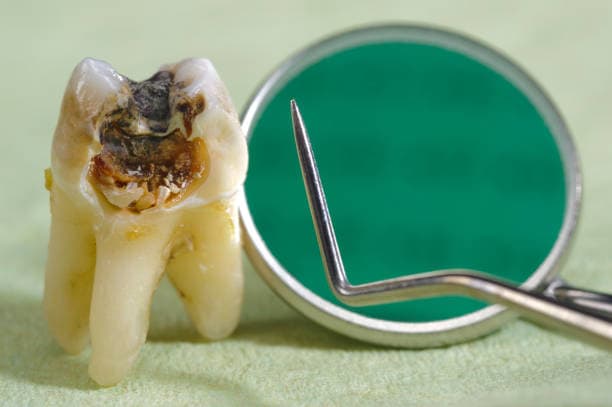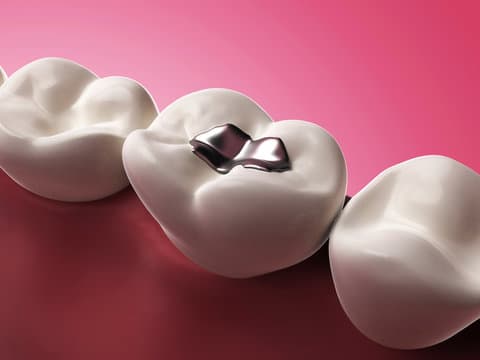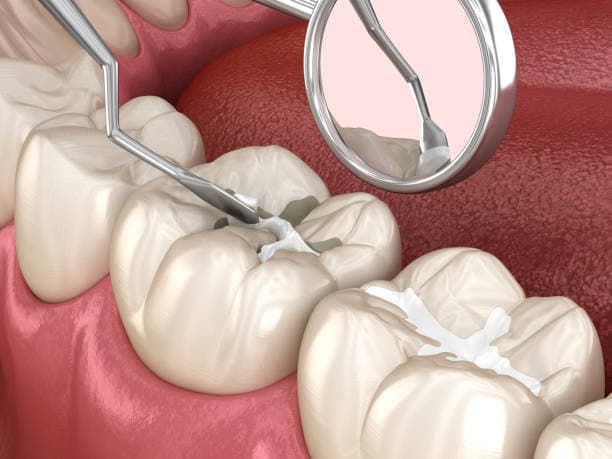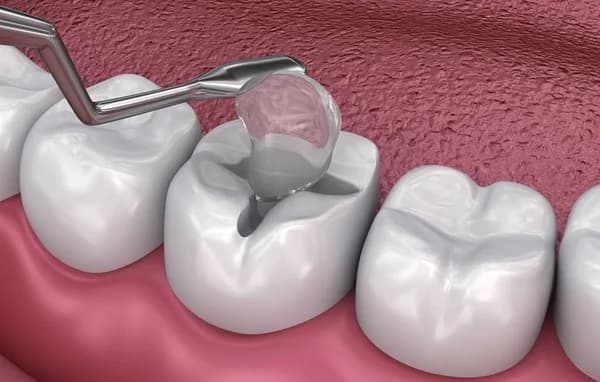Dental Filling Materials
Dental fillings are essential in restorative dentistry and are used to repair cavities and minor tooth damage. There are several types of dental fillingmaterials, each with unique properties, benefits, and drawbacks. The most common materials include amalgam, composite resin, glass ionomer, and ceramic.
Amalgam fillings are silver-colored and consist of a mixture of metals, including mercury, silver, tin, zinc, and copper. They are known for their durability and strength, making them suitable for filling cavities in the back teeth where chewing pressure is highest. However, their metallic color makes them less aesthetically pleasing, and concerns about mercury content have led to a decline in their use.
Composite resin fillings are tooth-colored and made from a resin base mixed with powdered quartz, silica, or glass. They are popular for their aesthetic appeal, as they can be closely matched to the natural color of teeth. Composite fillings bond directly to the tooth structure, providing additional support. However, they may not be as durable as amalgam fillings and can wear down over time, especially in areas with high chewing pressure.
Glass ionomer fillings are also tooth-colored and made from a mixture of silica glass powder and polyacrylic acid. They release fluoride, which can help protect the tooth from further decay. Glass ionomer fillings are often used for fillings in areas that are not subject to heavy chewing pressure, such as around the gum line or in primary (baby) teeth. They are less durable than composite and amalgam fillings and may need to be replaced more frequently.
Ceramic fillings, often made from porcelain, are another tooth-colored option. They are highly resistant to staining and can last for many years. Ceramic fillings are typically used for inlays, on-lays, and crowns rather than direct fillings. They require more than one dental visit to place, as they need to be custom-made in a dental laboratory. Ceramic fillings are more expensive than other types of fillings but offer excellent aesthetics and durability.
In addition to these common materials, there are also gold fillings, which are highly durable and can last for decades. However, they are less commonly used due to their high cost and noticeable appearance.
Choosing the right dental filling material depends on various factors, including the location and size of the cavity, the patient's dental history, and aesthetic preferences. Let’s get to know each material:

Amalgam Fillings
Amalgam fillings, commonly known as silver fillings, have been a cornerstone in restorative dentistry for over a century. These fillings are composed of a mixture of metals, including mercury, silver, tin, copper, and sometimes zinc. The process of combining these metals is known as amalgamation, which results in a durable and long-lasting material suitable for filling cavities. The metallic color of amalgam fillings can be quite noticeable, especially in visible areas of the mouth. This has led many patients to opt for tooth-colored alternatives like composite resins, which blend more seamlessly with natural teeth.
Mercury is a key component that helps bind the other metals together, but its presence has raised health and environmental concerns. While studies have shown that the amount of mercury released from amalgam fillings is minimal and generally considered safe, some patients and practitioners prefer to avoid it altogether. This has led to a decline in the use of amalgam fillings in favor of other materials. Despite these concerns, amalgam fillings remain a popular choice due to their strength, longevity, and cost-effectiveness. They are particularly useful in situations where durability is paramount, such as in large cavities or areas subjected to heavy chewing forces. Dentists continue to use amalgam fillings as a reliable option for restoring damaged teeth, ensuring that patients receive a restoration that can withstand the test of time.
Pros & Cons of Amalgam Fillings
Amalgam fillings, often referred to as silver fillings, have been a mainstay in dental restorative procedures for over a century. They are composed of a mixture of metals, including mercury, silver, tin, and copper, which together form a durable and long-lasting material.
Pros of Amalgam Fillings
Durability: One of the most significant advantages of amalgam fillings is their durability. They can withstand the forces of chewing and grinding, making them ideal for use in molars and other areas of the mouth that experience high pressure. Amalgam fillings can last for many years, often outlasting other types of fillings such as composite resins and glass ionomers.
Cost-Effective: Amalgam fillings are generally less expensive than other types of fillings. This makes them a cost-effective option for patients, especially those who may not have dental insurance or are on a tight budget.
Ease of Placement: The material is pliable when first mixed, allowing dentists to shape it to fit the cavity precisely. Once in place, it hardens quickly, providing a strong and stable restoration. This property also means that amalgam fillings are less technique-sensitive compared to other materials, reducing the risk of errors during the placement process.
Cons of Amalgam Fillings
Aesthetic Concerns: One of the most significant drawbacks of amalgam fillings is their metallic color, which can be quite noticeable, especially in visible areas of the mouth. This has led many patients to opt for tooth-colored alternatives like composite resins, which blend more seamlessly with natural teeth.
Mercury Content: The presence of mercury in amalgam fillings has raised health and environmental concerns. While studies have shown that the amount of mercury released from amalgam fillings is minimal and generally considered safe, some patients and practitioners prefer to avoid it altogether. This has led to a decline in the use of amalgam fillings in favor of other materials.
Potential for Tooth Fracture: Amalgam fillings can expand and contract with temperature changes in the mouth, which can sometimes lead to cracks or fractures in the surrounding tooth structure. This is less of a concern with newer filling materials like composite resins.
Removal of Healthy Tooth Structure: To place an amalgam filling, dentists often need to remove more of a healthy tooth structure compared to other types of fillings. This can weaken the tooth and potentially lead to further dental issues down the line.

Composite Fillings
Composite fillings, also known as tooth-colored fillings, have become a popular choice in modern dentistry due to their aesthetic appeal and versatility. These fillings are made from a mixture of plastic resin and finely ground glass particles, which can be closely matched to the natural color of teeth. This makes them an excellent option for patients who want their dental restorations to blend seamlessly with their natural teeth. Unlike amalgam fillings, which are metallic and can be quite noticeable, composite fillings can be color-matched to the surrounding teeth, making them virtually invisible. This is particularly beneficial for fillings in visible areas of the mouth, such as the front teeth. Composite fillings are also versatile. They can be used to repair not only cavities but also chipped, broken, or worn teeth.
Additionally, they can be used for cosmetic improvements, such as reshaping disfigured teeth or closing gaps between teeth. Composite fillings can also be sensitive to temperature changes. Some patients may experience temporary sensitivity to hot and cold foods and beverages after the filling is placed. This sensitivity usually subsides over time but can be uncomfortable initially.
Pros & Cons of Composite Fillings
Composite fillings, also known as tooth-colored fillings, have become increasingly popular in modern dentistry due to their aesthetic appeal and versatility. These fillings are made from a mixture of plastic resin and finely ground glass particles, which can be closely matched to the natural color of teeth.
Pros of Composite Fillings
Aesthetic Appeal: One of the most significant advantages of composite fillings is their ability to blend seamlessly with natural teeth. Unlike amalgam fillings, which are metallic and can be quite noticeable, composite fillings can be color-matched to the surrounding teeth, making them virtually invisible. This is particularly beneficial for fillings in visible areas of the mouth, such as the front teeth.
Bonding Capability: Composite resin bonds directly to the tooth structure, which can help to support the remaining tooth and prevent breakage. This bonding process also allows for a more conservative approach to cavity preparation, as less healthy tooth structure needs to be removed compared to amalgam fillings.
Versatility: Composite fillings are versatile and can be used to repair not only cavities but also chipped, broken, or worn teeth. Additionally, they can be used for cosmetic improvements, such as reshaping disfigured teeth or closing gaps between teeth.
Cons of Composite Fillings
Durability: While composite fillings are quite strong, they are not as durable as amalgam fillings and may not last as long, especially in areas of the mouth that experience heavy chewing pressure. They are more prone to wear and can sometimes chip or crack over time.
Cost: Composite fillings are generally more expensive than amalgam fillings. This is due to the materials used and the additional time required to place them. The procedure for placing a composite filling is more technique-sensitive and requires the tooth to be kept dry and free of contaminants during the process.
Sensitivity to Temperature Changes: Some patients may experience temporary sensitivity to hot and cold foods and beverages after the filling is placed. This sensitivity usually subsides over time but can be uncomfortable initially.
Potential for Staining: Composite fillings can stain over time, especially if the patient consumes a lot of coffee, tea, red wine, or other staining substances. This can affect the appearance of the filling and may require replacement or additional cosmetic treatments.

Gold Fillings
Gold dental fillings, also known as gold inlays or on-lays, have a long and storied history in dentistry, dating back to ancient civilizations such as the Egyptians and Romans. These fillings are made from a gold alloy, typically mixed with other metals like silver, copper, and palladium, to create a strong and durable material that can withstand the rigors of chewing and grinding.
Gold is a highly malleable material that can withstand the forces of chewing without fracturing or wearing down easily. This makes gold fillings particularly suitable for large cavities in the back teeth (molars and premolars), where the pressure from chewing is greatest. With proper care, gold fillings can last up to 30 years or even longer, making them a cost-effective option in the long run.
Gold fillings also offer a perfect fit. They are custom-made to fit the shape and size of the cavity precisely, preventing bacteria from entering and causing recurrent decay. This tight seal contributes to improved oral health and reduces the likelihood of further dental issues. Furthermore, the placement of gold fillings requires minimal removal of healthy tooth structure, preserving the natural strength and integrity of the tooth.
Pros & Cons of Gold Fillings
Gold dental fillings have been a trusted choice in dentistry for many years due to their durability and biocompatibility.
Pros of Gold Fillings
Exceptional Durability: One of the most significant advantages of gold fillings is their durability. Gold is a highly malleable material that can withstand the forces of chewing and grinding without fracturing or wearing down easily. This makes gold fillings particularly suitable for large cavities in the back teeth (molars and premolars), where the pressure from chewing is greatest. With proper care, gold fillings can last up to 30 years or even longer, making them a cost-effective option in the long run.
Biocompatibility: Gold is a biocompatible material, meaning it is unlikely to cause any allergic reactions or adverse effects in the oral tissues or body. This makes gold fillings an excellent choice for individuals with metal sensitivities or allergies. Additionally, gold fillings have a similar coefficient of thermal expansion as natural tooth structures, meaning they expand and contract at the same rate. This reduces the risk of cracks or fractures in the tooth, providing a stable and long-lasting restoration.
Perfect Fit: Gold fillings are custom-made to fit the shape and size of the cavity precisely, preventing bacteria from entering and causing recurrent decay. This tight seal contributes to improved oral health and reduces the likelihood of further dental issues. Furthermore, the placement of gold fillings requires minimal removal of healthy tooth structure, preserving the natural strength and integrity of the tooth.
Cons of Gold Fillings
Aesthetic Appearance: One of the most significant drawbacks of gold fillings is their noticeable metallic color. This can be quite conspicuous, especially in visible areas of the mouth, making them less desirable for individuals seeking a natural-looking smile. This has led many patients to opt for tooth-colored alternatives like composite resins or porcelain fillings, which blend more seamlessly with natural teeth.
Cost: Gold fillings are generally more expensive than other types of fillings, such as amalgam or composite. This higher cost is due to the materials used and the additional time required to fabricate and place the filling. Additionally, the procedure for placing gold fillings typically requires multiple dental visits, which can be inconvenient for some patients.
Thermal Conductivity: Gold is a good conductor of heat and cold, which can sometimes lead to increased sensitivity to temperature changes in the mouth. This sensitivity is usually temporary but can be uncomfortable for some patients.

Ceramic Fillings
Ceramic dental fillings, also known as porcelain fillings, are a popular choice in modern dentistry due to their aesthetic appeal and durability. These fillings are made from a type of ceramic material, typically porcelain, which closely resembles the natural color and translucency of tooth enamel. This makes them an excellent option for patients who want their dental restorations to blend seamlessly with their natural teeth.
Ceramic materials can be color-matched to the surrounding teeth, making the fillings virtually invisible. This is particularly beneficial for fillings in visible areas of the mouth, such as the front teeth. Additionally, ceramic fillings are highly resistant to staining, which helps maintain their natural appearance over time. Ceramic fillings also offer a perfect fit. They are custom-made to fit the shape and size of the cavity precisely, preventing bacteria from entering and causing recurrent decay. This tight seal contributes to improved oral health and reduces the likelihood of further dental issues. Ceramic dental fillings offer numerous benefits, including exceptional aesthetic appeal, durability, and a perfect fit. However, their brittleness and higher cost may be drawbacks for some individuals. Patients should discuss their options with their dentist to determine the best type of filling material for their specific needs, taking into account factors such as durability, aesthetics, and budget.
Pros & Cons of Ceramic Fillings
Ceramic dental fillings, also known as porcelain fillings, are a popular choice in modern dentistry due to their aesthetic appeal and durability.
Pros of Ceramic Fillings
Aesthetic Appeal: One of the most significant advantages of ceramic fillings is their ability to blend seamlessly with natural teeth. Ceramic materials can be color-matched to the surrounding teeth, making the fillings virtually invisible. This is particularly beneficial for fillings in visible areas of the mouth, such as the front teeth. Additionally, ceramic fillings are highly resistant to staining, which helps maintain their natural appearance over time.
Durability: Ceramic is a strong and long-lasting material that can withstand the forces of chewing and grinding. With proper care, ceramic fillings can last for many years, often outlasting other types of fillings such as composite resins. This makes them a cost-effective option in the long run, despite their higher initial cost.
Biocompatibility: Ceramic fillings are biocompatible, meaning they are well-tolerated by the body and unlikely to cause any allergic reactions or adverse effects in the oral tissues. This makes them an excellent choice for individuals with metal sensitivities or allergies.
Perfect Fit: Ceramic fillings are custom-made to fit the shape and size of the cavity precisely, preventing bacteria from entering and causing recurrent decay. This tight seal contributes to improved oral health and reduces the likelihood of further dental issues. Furthermore, the placement of ceramic fillings requires minimal removal of healthy tooth structure, preserving the natural strength and integrity of the tooth.
Cons of Ceramic Fillings
Brittleness: While ceramic is a strong material, it can be more brittle compared to other filling materials like composite resin or amalgam. This means that ceramic fillings can sometimes crack or chip under heavy chewing pressure or if the patient has a habit of grinding their teeth.
Cost: Ceramic fillings are generally more expensive than other types of fillings, such as amalgam or composite. This higher cost is due to the materials used and the additional time required to fabricate and place the filling. Additionally, the procedure for placing ceramic fillings typically requires multiple dental visits, which can be inconvenient for some patients.
Time-Consuming Procedure: The process of placing ceramic fillings is more time-consuming compared to other types of fillings. It often requires multiple appointments, as the fillings need to be custom-made in a dental laboratory before being placed in the patient's mouth.

Glass Ionomer Fillings
Glass ionomer dental fillings, often referred to as GICs (Glass Ionomer Cements), are a unique and versatile type of dental restorative material. Developed in the late 20th century, these fillings have gained popularity due to their biocompatibility and ability to release fluoride, which helps protect teeth from further decay.
The material is composed of a combination of glass powder and an organic acid, such as polyacrylic acid. This composition allows the filling to release fluoride over time, which can help remineralize the tooth and prevent future cavities. This makes glass ionomer fillings particularly beneficial for patients who are prone to tooth decay or have a high risk of developing cavities.
Glass ionomer dental fillings offer numerous benefits, including fluoride release, chemical bonding, and biocompatibility. However, their strength and initial acidity may be drawbacks for some individuals. Patients should discuss their options with their dentist to determine the best type of filling material for their specific needs, taking into account factors such as durability, aesthetics, and risk of tooth decay.
Pros & Cons of Glass Ionomer Fillings
Glass ionomer dental fillings, often referred to as GICs (Glass Ionomer Cements), are a unique and versatile type of dental restorative material.
Pros of Glass Ionomer Fillings
Fluoride Release: One of the primary advantages of glass ionomer fillings is their ability to release fluoride over time. This fluoride release helps remineralize the tooth and prevent future cavities, making them particularly beneficial for patients who are prone to tooth decay or have a high risk of developing cavities.
Chemical Bonding: Glass ionomer fillings bond chemically to the tooth structure without the need for additional bonding agents. This creates a strong and durable seal that helps prevent bacteria from entering and causing recurrent decay. The chemical bond also reduces the need for extensive removal of healthy tooth structure, preserving the natural integrity of the tooth.
Biocompatibility: Glass ionomer fillings are well-tolerated by the body and are unlikely to cause any allergic reactions or adverse effects in the oral tissues. This makes them an excellent choice for individuals with metal sensitivities or allergies. Additionally, they are less sensitive to moisture during placement compared to composite fillings, making them easier to work within certain clinical situations.
Cons of Glass Ionomer Fillings
Strength: One of the most significant drawbacks of glass ionomer fillings is their strength. While they are durable, they are not as strong as other types of fillings, such as amalgam or composite. This means they may not be suitable for use in areas of the mouth that experience heavy chewing pressure, such as the molars. They are more prone to wear and may need to be replaced more frequently.
Initial Acidity: Glass ionomer fillings start off very acidic due to the polyalkenoic acids used in their composition. This can irritate the tooth pulp if not used properly. Dentists often use a protective layer, such as calcium hydroxide, in deeper cavities to counteract this acidity.
Aesthetic Appearance: While glass ionomer fillings can be color-matched to the surrounding teeth, they are not as aesthetically pleasing as composite or ceramic fillings. The color may not be a perfect match to the natural tooth, and the material can become rough over time.
Moisture Sensitivity: Although less sensitive to moisture than composites, glass ionomer fillings still require a relatively dry environment during placement to set properly. This can be challenging in certain clinical situations.

Conclusion
In conclusion, the choice of dental filling material plays a crucial role in restorative dentistry, impacting both the functionality and aesthetics of the restoration. Amalgam fillings offer exceptional durability and cost-effectiveness, making them suitable for high-pressure areas like molars. Composite fillings provide a natural appearance and versatility, ideal for visible areas of the mouth. Ceramic fillings combine aesthetic appeal with durability, though they come at a higher cost. Glass ionomer fillings release fluoride, offering additional protection against decay, but may not be as strong as other materials. Gold fillings, while less common, provide unmatched longevity and biocompatibility. Ultimately, the best filling material depends on individual needs, including the location and size of the cavity, aesthetic preferences, and budget. Consulting with a dentist can help patients make informed decisions to achieve optimal oral health and a confident smile.
Read More